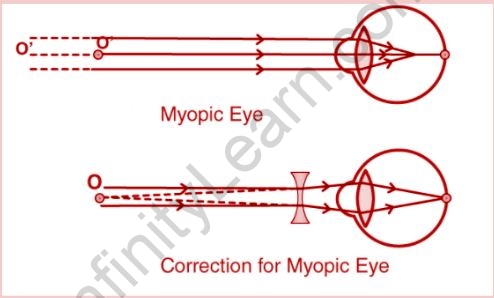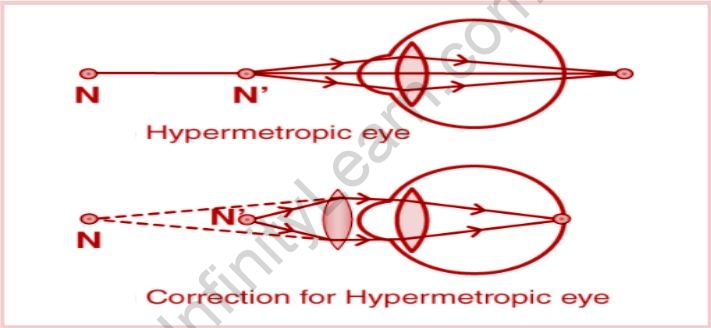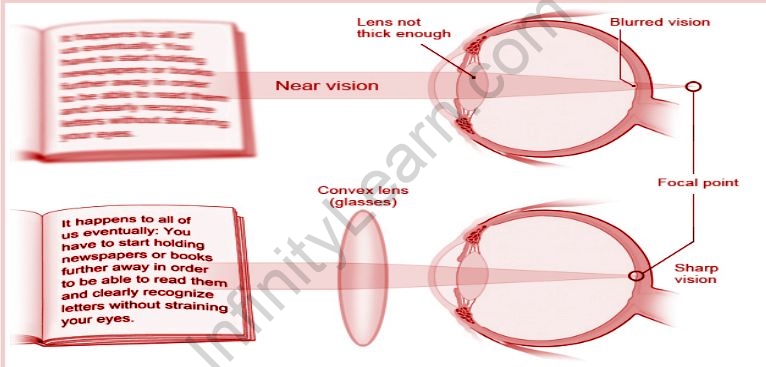Table of Contents
Introduction
Nature has blessed us with one of the most priceless gifts called vision. The human eye is one of the five senses that humans have and is a part of the sensory nervous system. It reacts to light and assists humans in achieving their eyesight. The pupil, lens, retina, cornea, iris, and other accessory organs make up the human eye. For humans to obtain their sensation of vision, all of the eye’s accessory organs must act together. Although the human eye can see both near and farthings, the working process in each situation is distinct. Because the rays diverge and become parallel when they reach the eye when looking at far objects, the concave eye lens is necessary to see distant objects because it has a high focal length and is also thick. Whenever we look at adjacent objects, however, the object rays diverge as they approach the eye. A convex eye lens with a strong convergence power and a short focal length is necessary for this circumstance.
Overview
The eye lens is made of a fibrous, jelly-like substance. With the help of ciliary muscles, the curvature of the eye lens can be altered to a certain degree. The focal length of the eye lens can fluctuate depending on its curvature. When the eye muscles relax, the eye lens becomes thinner and the focus length rises. When the focal length is increased, distant objects can be plainly seen. The ciliary muscles contract to increase the curvature of the lens and hence shorten the focal length in order to see objects that are nearby. We can say that accommodation is the capability of the eye lens to change its focal length.
Defects in the eye can occur for a variety of causes. As people become older, their vision deteriorates, and as the focal length changes, so does their vision. The most frequent eye defect is cataract, as we all know. When cataracts are not treated appropriately, they might result in partial or complete vision loss. A cataract occurs when the crystalline lens gets milky and clouded with age. The vision of a person who has cataract surgery can be regained.
When the eye’s capacity to adapt its focus length is lost, difficulties such as blurred vision, inability to perceive local objects, and inability to see far away items arise. When a refractive index deficiency occurs, the person is unable to see objects clearly and comfortably. If not treated promptly, the eyes’ ability to accommodate may be lost totally.
The information about eye defects from various physics-related articles are available here. Eye defects and its general concepts are important topics in physics. Students who want to flourish in physics need to be well known about eye defects and their correction to get deep knowledge about it to do well on their exams. The definition, brief explanation, and treatments of various eye defects are provided here to assist students in effectively understanding the respective topic. Continue to visit our website for additional physics help.
Eye Defects
Eye defects are a serious health risk in today’s world; they are described as the inability of the ciliary muscles to change the shape of the eye lens. The ciliary muscles’ dysfunction can result in issues with picture generation of any object in the retina, which can lead to vision loss. The three most frequent types of human eye problems are:
- Near-sightedness or Myopia
- Farsightedness or Hypermetropia
- Presbyopia
(1) Myopia
Myopia is defined as a situation in which a person cannot see distant objects clearly until the object is brought closer to the eye. It is known that near-sightedness or short-sightedness are other names for myopia. Myopic patients can plainly see all of the closer items.
Myopia is mainly caused by two factors:
- High converging power of the lens
- Eye-ball elongation
Because of the high convergence of the eye lens, when the image is created in front of the retina, the person is unable to see distant objects well.
The retina becomes distant from the eye-lens in the second scenario, which occurs when the eyeball becomes overly elongated. The eye lens has strong converging power here, but the image is generated in front of the retina as well.
During driving, the person’s eyesight becomes fuzzy due to myopia. This condition can start in childhood and progress slowly or quickly depending on the eye’s power.
Eye strain, weariness, headache, and squinting are the most prevalent symptoms of an overgrowing eye condition. When a person reads a book or uses a computer attentively, myopia develops. This can happen to anyone who doesn’t spend enough time outside.
Correction: Near-sighted or short-sighted people are required to wear spectacles with a concave lens if they have near-sightedness or short-sightedness. Because the lens diverges the parallel light rays originating from distant objects, a concave lens is utilized to treat myopia. As a result, the virtual image is produced at a position far away in the myopic eye.
The objects may now be readily focussed by the lens since the light rays are at the right distance, and the image is produced on the retina. To put it another way, the concave lens reduces the convergence power. A refractive survey or contact lenses can also be used to cure myopia. Despite the fact that refractive surgery is pricey, it has positive benefits in the end. Myopia comes in a variety of degrees.

(2) Hypermetropia
Far-sightedness is the usual name for hypermetropia. The person can see objects at a distance but not clearly notice anything close by in this condition. To see surrounding objects, the person with this disease usually squints. When light rays from a nearby object are focused at a position behind the retina, hypermetropia occurs.
Whenever the eye’s power is insufficient or the eye’s length is insufficient, light rays enter the eye and fall behind the retina, rather than focusing on the retina. Hypermetropia causes blurred vision, typically at close range, but it can also compromise distance vision depending on its degree. Its symptoms includes:
- Blurry vision.
- Headaches due to eyestrain.
- Squinting.
Correction: Corrective contact lenses or spectacles can be used to treat hypermetropia. Eye surgery, on the other hand, can be a very effective alternative for the right patients.
Traditional correction: positive lenses in spectacles or contact lenses.
Surgical treatment: Laser Eye Surgery and Clear Lens Extraction are the two surgical methods available. The latter is similar to cataract surgery except it removes a clear crystalline lens (with no cataract).
If surgical correction is your preferred hypermetropia treatment, it is critical to discuss your options with your eye surgeon. Your age, the severity of your hypermetropia, the thickness of your corneas, and whether you have any other eye diseases are all considerations to consider.

(3) Presbyopia
Variations in the lens inside the eye create presbyopia. The lens hardens and becomes less elastic as people age, making it more difficult for the eye to focus on close objects. Presbyopia is a vision problem caused by the ciliary muscles of the eye lens deteriorating. Presbyopia is a condition that affects people over the age of 40. The following are some of the most prevalent visual symptoms:
- Trouble reading small print.
- When reading, brighter light is required.
- When reading or conducting close-up work, you may have eye strain or headaches.
- Focusing on objects that are closer to you is difficult.
Correction: Glasses, contact lenses, or surgery can all be used to treat presbyopia. Glasses with bifocal power and appropriate focal lengths are frequently used to remedy this problem. The upper half of the lens is concave, which corrects myopia and allows you to see distant objects clearly, while the lower part is convex, which corrects hypermetropia and allows you to see nearer items clearly.

Also read: Important Topic of Physics: Wave Optics
Frequently Asked Questions (FAQs)
What is the process of formation of the image in the eyes?
Our human eye collects light rays that are reflected from things; this action of light being reflected from a certain surface gives images their colour dimension. Such rays initially make contact with the retina of the human eye, where they are handled later. Our retina is extremely sensitive to light intensity, and once the intensity is high, the retina contracts, and when the intensity is low, the retina stretches. This image made by the human eye is inverted, and this is rectified in the brain.
Is Near-sightedness genetic?
Although there is no conclusive evidence to prove the source of this eye impairment, there is some indication that myopia is inherited. As previously stated, near-sightedness is caused by either high converging power or the growth of excessively long eyeballs. Myopia, on the other hand, is not an illness; it occurs as a result of a refractive index problem. Although genes have a role in myopia development, environmental variables play a far larger impact on the development of near-sightedness. One of the key causes is poor vision due to poor food habits and increased usage of phones and laptops.
What is the reason for hypermetropia?
Because light rays from a nearby object are focused at a position below the retina, the person is unable to distinguish between nearby things.





